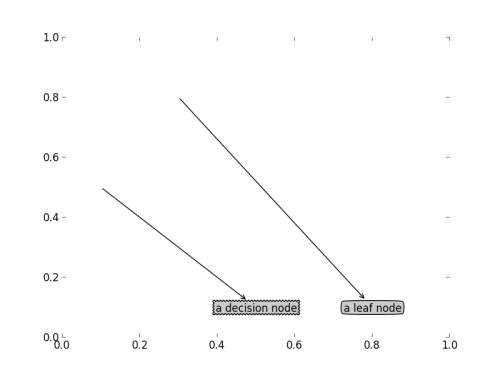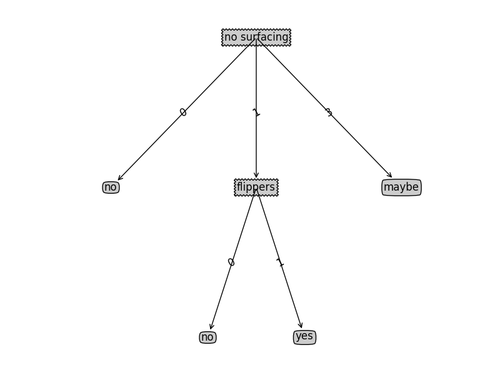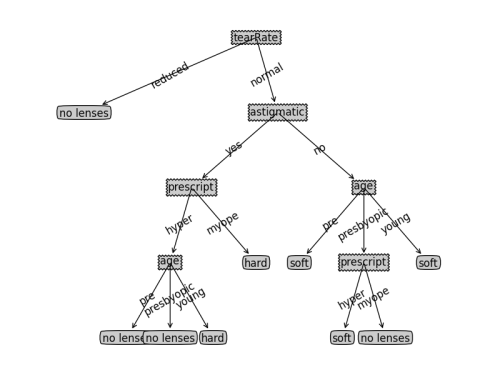機器學習實戰精讀--------決策樹
阿新 • • 發佈:2017-08-17
決策樹 機器學習 python
感覺自己像個學走路的孩子,每一步都很吃力和認真!
機器根據數據集創建規則,就是機器學習。
決策樹:從數據集合中提取一系列規則,適用於探索式的知識發現。
決策樹本質:通過一系列規則對數據進行分類的過程。
決策樹算法核心:構建精度高,數據規模小的決策樹。
ID3算法:此算法目的在於減少樹的深度,但是忽略了葉子數目的研究。
C4.5算法:對ID3進行改進,對於預測變量的缺失值處理、剪枝技術、派生規則等方面作了較大改進,既適合分類,又適合回歸。
香農熵:變量的不確定性越大,熵也就越大,把它搞清楚所需要的信息量也就越大。
基尼不純度:一個隨機事件變成它的對立事件的概率。
#coding:utf-8
from math import log
import operator
#創建數據
def createDataSet():
dataSet = [[1, 1, ‘yes‘],
[1, 1, ‘yes‘],
[1, 0, ‘no‘],
[0, 1, ‘no‘],
[0, 1, ‘no‘]]
labels = [‘no surfacing‘,‘flippers‘]
#change to discrete values
return dataSet, labels
#計算給定數據集的香農熵
def calcShannonEnt(dataSet):
numEntries = len(dataSet)
#輸出列表的的長度 值為:5
labelCounts = {}
for featVec in dataSet:
#對二維數組進行遍歷
currentLabel = featVec[-1]
#把每個子列表的最後一個元素賦值給currentLabel
if currentLabel not in labelCounts.keys(): labelCounts[currentLabel] = 0
#如果currentLabel 不在字典中,把字典的值設置為0
# keys() 函數以列表返回一個字典所有的鍵。
labelCounts[currentLabel] += 1
#這一步是統計出現的次數,每次匹配到的話,把對應key的值加1
#操作完以後labelCounts字典記錄的是yes出現2次 no出現3次
shannonEnt = 0.0
for key in labelCounts:
prob = float(labelCounts[key])/numEntries
#prob是字典labelCounts每個key的比率
shannonEnt -= prob * log(prob,2)
#log(x, 2) 表示以2為底的對數。
return shannonEnt
#熵數字越大,說明混合的數據越多
#按照給定特征劃分數據集
def splitDataSet(dataSet, axis, value):
#dataSet:待劃分的數據集;axis:劃分數據集的特征;value:需要返回的特征的值
retDataSet = []
for featVec in dataSet:
if featVec[axis] == value:
#如果featVec列表的特征值跟valve值一樣
reducedFeatVec = featVec[:axis]
#輸出列表featVec開頭到特征值的列表切片
reducedFeatVec.extend(featVec[axis+1:])
retDataSet.append(reducedFeatVec)
return retDataSet
#選擇最好的數據集劃分方式
def chooseBestFeatureToSplit(dataSet):
numFeatures = len(dataSet[0]) - 1 #the last column is used for the labels
baseEntropy = calcShannonEnt(dataSet)
bestInfoGain = 0.0; bestFeature = -1
for i in range(numFeatures): #iterate over all the features
featList = [example[i] for example in dataSet]#create a list of all the examples of this feature
uniqueVals = set(featList) #get a set of unique values
newEntropy = 0.0
for value in uniqueVals:
subDataSet = splitDataSet(dataSet, i, value)
prob = len(subDataSet)/float(len(dataSet))
newEntropy += prob * calcShannonEnt(subDataSet)
infoGain = baseEntropy - newEntropy #calculate the info gain; ie reduction in entropy
if (infoGain > bestInfoGain): #compare this to the best gain so far
bestInfoGain = infoGain #if better than current best, set to best
bestFeature = i
return bestFeature #returns an integer
def majorityCnt(classList):
classCount={}
for vote in classList:
if vote not in classCount.keys(): classCount[vote] = 0
classCount[vote] += 1
sortedClassCount = sorted(classCount.iteritems(), key=operator.itemgetter(1), reverse=True)
return sortedClassCount[0][0]
def createTree(dataSet,labels):
classList = [example[-1] for example in dataSet]
if classList.count(classList[0]) == len(classList):
return classList[0]#stop splitting when all of the classes are equal
if len(dataSet[0]) == 1: #stop splitting when there are no more features in dataSet
return majorityCnt(classList)
bestFeat = chooseBestFeatureToSplit(dataSet)
bestFeatLabel = labels[bestFeat]
myTree = {bestFeatLabel:{}}
del(labels[bestFeat])
featValues = [example[bestFeat] for example in dataSet]
uniqueVals = set(featValues)
for value in uniqueVals:
subLabels = labels[:] #copy all of labels, so trees don‘t mess up existing labels
myTree[bestFeatLabel][value] = createTree(splitDataSet(dataSet, bestFeat, value),subLabels)
return myTree
#使用決策樹的分類函數
def classify(inputTree,featLabels,testVec):
firstStr = inputTree.keys()[0]
secondDict = inputTree[firstStr]
featIndex = featLabels.index(firstStr)
key = testVec[featIndex]
valueOfFeat = secondDict[key]
if isinstance(valueOfFeat, dict):
classLabel = classify(valueOfFeat, featLabels, testVec)
else: classLabel = valueOfFeat
return classLabel
#使用pickle模塊存儲決策樹
def storeTree(inputTree,filename):
import pickle
fw = open(filename,‘w‘)
pickle.dump(inputTree,fw)
fw.close()
def grabTree(filename):
import pickle
fr = open(filename)
return pickle.load(fr)#coding:utf-8
import matplotlib as mpl
mpl.use(‘Agg‘)
import matplotlib.pyplot as plt
decisionNode = dict(boxstyle="sawtooth", fc="0.8")
leafNode = dict(boxstyle="round4", fc="0.8")
arrow_args = dict(arrowstyle="<-")
def getNumLeafs(myTree):
numLeafs = 0
firstStr = myTree.keys()[0]
secondDict = myTree[firstStr]
for key in secondDict.keys():
if type(secondDict[key]).__name__==‘dict‘:#test to see if the nodes are dictonaires, if not they are leaf nodes
numLeafs += getNumLeafs(secondDict[key])
else: numLeafs +=1
return numLeafs
def getTreeDepth(myTree):
maxDepth = 0
firstStr = myTree.keys()[0]
secondDict = myTree[firstStr]
for key in secondDict.keys():
if type(secondDict[key]).__name__==‘dict‘:#test to see if the nodes are dictonaires, if not they are leaf nodes
thisDepth = 1 + getTreeDepth(secondDict[key])
else: thisDepth = 1
if thisDepth > maxDepth: maxDepth = thisDepth
return maxDepth
def plotNode(nodeTxt, centerPt, parentPt, nodeType):
createPlot.ax1.annotate(nodeTxt, xy=parentPt, xycoords=‘axes fraction‘,
xytext=centerPt, textcoords=‘axes fraction‘,
va="center", ha="center", bbox=nodeType, arrowprops=arrow_args )
def plotMidText(cntrPt, parentPt, txtString):
xMid = (parentPt[0]-cntrPt[0])/2.0 + cntrPt[0]
yMid = (parentPt[1]-cntrPt[1])/2.0 + cntrPt[1]
createPlot.ax1.text(xMid, yMid, txtString, va="center", ha="center", rotation=30)
def plotTree(myTree, parentPt, nodeTxt):#if the first key tells you what feat was split on
numLeafs = getNumLeafs(myTree) #this determines the x width of this tree
depth = getTreeDepth(myTree)
firstStr = myTree.keys()[0] #the text label for this node should be this
cntrPt = (plotTree.xOff + (1.0 + float(numLeafs))/2.0/plotTree.totalW, plotTree.yOff)
plotMidText(cntrPt, parentPt, nodeTxt)
plotNode(firstStr, cntrPt, parentPt, decisionNode)
secondDict = myTree[firstStr]
plotTree.yOff = plotTree.yOff - 1.0/plotTree.totalD
for key in secondDict.keys():
if type(secondDict[key]).__name__==‘dict‘:#test to see if the nodes are dictonaires, if not they are leaf nodes
plotTree(secondDict[key],cntrPt,str(key)) #recursion
else: #it‘s a leaf node print the leaf node
plotTree.xOff = plotTree.xOff + 1.0/plotTree.totalW
plotNode(secondDict[key], (plotTree.xOff, plotTree.yOff), cntrPt, leafNode)
plotMidText((plotTree.xOff, plotTree.yOff), cntrPt, str(key))
plotTree.yOff = plotTree.yOff + 1.0/plotTree.totalD
#if you do get a dictonary you know it‘s a tree, and the first element will be another dict
def createPlot(inTree):
fig = plt.figure(1, facecolor=‘white‘)
fig.clf()
axprops = dict(xticks=[], yticks=[])
createPlot.ax1 = plt.subplot(111, frameon=False, **axprops) #no ticks
#createPlot.ax1 = plt.subplot(111, frameon=False) #ticks for demo puropses
plotTree.totalW = float(getNumLeafs(inTree))
plotTree.totalD = float(getTreeDepth(inTree))
plotTree.xOff = -0.5/plotTree.totalW; plotTree.yOff = 1.0;
plotTree(inTree, (0.5,1.0), ‘‘)
plt.savefig(‘trees.png‘)
‘‘‘
def createPlot():
fig = plt.figure(1, facecolor=‘white‘)
#創建第一張圖,設置背景色是白色
fig.clf()
createPlot.ax1 = plt.subplot(111, frameon=False) #ticks for demo puropses
plotNode(‘a decision node‘, (0.5, 0.1), (0.1, 0.5), decisionNode)
plotNode(‘a leaf node‘, (0.8, 0.1), (0.3, 0.8), leafNode)
plt.savefig(‘trees.png‘)
‘‘‘
def retrieveTree(i):
listOfTrees =[{‘no surfacing‘: {0: ‘no‘, 1: {‘flippers‘: {0: ‘no‘, 1: ‘yes‘}}}},
{‘no surfacing‘: {0: ‘no‘, 1: {‘flippers‘: {0: {‘head‘: {0: ‘no‘, 1: ‘yes‘}}, 1: ‘no‘}}}}
]
return listOfTrees[i]



小結:
一、一棵最優決策樹主要應解決以下三個問題:
① 生成最少數目的葉子節點
② 生成每個葉子節點的深度最小
③ 生成的決策樹葉子節點最少且每個葉子節點深度最小
二、如果葉子節點只能增加少許信息,則可以刪除該節點,將它並入到其它節點中去。
三、ID3算法無法直接處理數值型數據。
四、采用文本方式很難展示決策樹,所以要用Matplotlib註解繪制樹型圖。
本文出自 “付煒超” 博客,謝絕轉載!
機器學習實戰精讀--------決策樹
